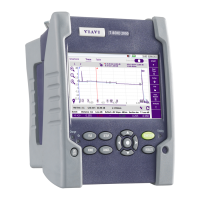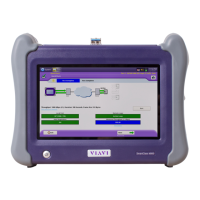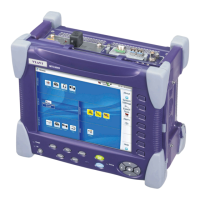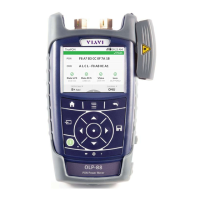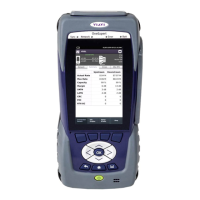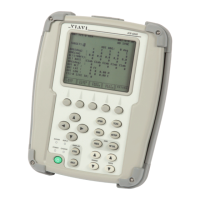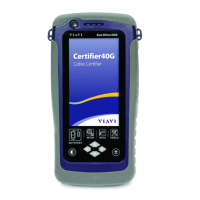Do you have a question about the Viavi MTS 8000 and is the answer not in the manual?
Portable, modular platform designed for the construction, validation and maintenance of optical fiber networks.
Explains optical time domain reflectometry, signal detection, and information yielded.
Explains how different fiber properties affect OTDR traces and the concept of bi-directional measurement.
Details power measurement using a power meter and attenuation measurement using a light source and power meter.
Explains Polarization Mode Dispersion (PMD) and its impact on transmission rate and bit-error-rate.
Details how to insert and remove modules into the T-BERD/MTS 8000 V2 and T-BERD/MTS 6000/6000A platforms.
Explains the importance of inspecting and cleaning connector end faces before mating.
Details how to configure acquisition parameters, alarms, analysis, link, and file settings for reflectometry tests.
Explains how to launch an OTDR measurement once configuration for acquisition and file storage is defined.
Guides the user through activating the RDZ function and configuring OTDR measurement parameters.
Explains how to launch an acquisition once the measurement parameters are correctly configured.
Explains how to save traces and generate reports directly from the results screen using the Fast Report function.
Details how to activate the power meter function and access its measurement parameters via the SETUP key.
Details the steps to start and stop a power level measurement using the power meter function.
Explains how to perform insertion loss measurements using a light source and power meter after carrying out a reference measurement.
Details how to access the OEO configuration menu and the necessary steps for proper setup.
Guides the user through the steps of an automatic bi-directional measurement, including process display and status monitoring.
Details how to save traces and generate reports directly from the results screen.
Explains the necessity of referencing leads/patch cords for meaningful measurements and lists reference methods.
Details how to configure acquisition parameters, alarms, analysis, link, and file settings for FiberComplete.
Outlines the steps for performing tests after setup is configured on both units, including automatic pairing and continuity check.
Explains how to save results and generate reports directly from the results screen.
Details how to configure the Platform 8000 for OSA tests, including setup in Test Auto mode and various measurement parameters.
Guides the user through selecting the PMD function and performing auto-calibration.
Guides the user through activating the IPMD function and configuring acquisition parameters.
Explains the mandatory Zero Referencing procedure for High OSNR accuracy before the first measurement.
Details the installation and procedure for performing in-band PMD-OSNR measurements using an I-PMD module.
Guides the user through the instrument configuration menu and details various setup parameters.
Guides the user through validating the AP function and performing auto-calibration.
Details the mandatory broadband source referencing procedure for accurate AP measurements.
Outlines the steps to perform a AP measurement after the reference measurement is completed.
Details how to configure measurement parameters for chromatic dispersion tests.
Explains the mandatory referencing procedure for CD measurements, especially when using OBS-5XX or BBS.
Outlines the steps to perform a CD measurement after the reference measurement is completed.
Explains how to save traces and generate reports from the results screen.
Guides the user through activating the BBS function by selecting its icon and entering the password.
Guides the user to access the MTAU function configuration screen to switch input channels.
Details how to connect OTDR and ODM modules to MTAU ports for fiber characterization scripts.
Explains that test functions like FCOMP, CD, and AP require REFERENCING before performing tests.
Details the two types of macros (Standard and File) and the requirements for starting macro recording.
Details how to save active traces, load files, and manage overlay configurations.
Portable, modular platform designed for the construction, validation and maintenance of optical fiber networks.
Explains optical time domain reflectometry, signal detection, and information yielded.
Explains how different fiber properties affect OTDR traces and the concept of bi-directional measurement.
Details power measurement using a power meter and attenuation measurement using a light source and power meter.
Explains Polarization Mode Dispersion (PMD) and its impact on transmission rate and bit-error-rate.
Details how to insert and remove modules into the T-BERD/MTS 8000 V2 and T-BERD/MTS 6000/6000A platforms.
Explains the importance of inspecting and cleaning connector end faces before mating.
Details how to configure acquisition parameters, alarms, analysis, link, and file settings for reflectometry tests.
Explains how to launch an OTDR measurement once configuration for acquisition and file storage is defined.
Guides the user through activating the RDZ function and configuring OTDR measurement parameters.
Explains how to launch an acquisition once the measurement parameters are correctly configured.
Explains how to save traces and generate reports directly from the results screen using the Fast Report function.
Details how to activate the power meter function and access its measurement parameters via the SETUP key.
Details the steps to start and stop a power level measurement using the power meter function.
Explains how to perform insertion loss measurements using a light source and power meter after carrying out a reference measurement.
Details how to access the OEO configuration menu and the necessary steps for proper setup.
Guides the user through the steps of an automatic bi-directional measurement, including process display and status monitoring.
Details how to save traces and generate reports directly from the results screen.
Explains the necessity of referencing leads/patch cords for meaningful measurements and lists reference methods.
Details how to configure acquisition parameters, alarms, analysis, link, and file settings for FiberComplete.
Outlines the steps for performing tests after setup is configured on both units, including automatic pairing and continuity check.
Explains how to save results and generate reports directly from the results screen.
Details how to configure the Platform 8000 for OSA tests, including setup in Test Auto mode and various measurement parameters.
Guides the user through selecting the PMD function and performing auto-calibration.
Guides the user through activating the IPMD function and configuring acquisition parameters.
Explains the mandatory Zero Referencing procedure for High OSNR accuracy before the first measurement.
Details the installation and procedure for performing in-band PMD-OSNR measurements using an I-PMD module.
Guides the user through the instrument configuration menu and details various setup parameters.
Guides the user through validating the AP function and performing auto-calibration.
Details the mandatory broadband source referencing procedure for accurate AP measurements.
Outlines the steps to perform a AP measurement after the reference measurement is completed.
Details how to configure measurement parameters for chromatic dispersion tests.
Explains the mandatory referencing procedure for CD measurements, especially when using OBS-5XX or BBS.
Outlines the steps to perform a CD measurement after the reference measurement is completed.
Explains how to save traces and generate reports from the results screen.
Guides the user through activating the BBS function by selecting its icon and entering the password.
Guides the user to access the MTAU function configuration screen to switch input channels.
Details how to connect OTDR and ODM modules to MTAU ports for fiber characterization scripts.
Explains that test functions like FCOMP, CD, and AP require REFERENCING before performing tests.
Details the two types of macros (Standard and File) and the requirements for starting macro recording.
Details how to save active traces, load files, and manage overlay configurations.
| Model | MTS 8000 |
|---|---|
| Platform Type | Modular |
| Battery Life | Up to 8 hours |
| Humidity | 5% to 95% non-condensing |
| Measurement Capabilities | OTDR |
| Optical Testing Capabilities | OTDR, Optical Power Meter, Light Source |
| Dynamic Range | Up to 45 dB |
| Display | Color TFT LCD Touchscreen |
| Weight | Approx. 3.5 kg |
| Connectivity | USB, Ethernet |
| Interfaces | USB, Ethernet |
| Operating Temperature | -10 to +50 °C |
| Storage Temperature | -20 to +60 °C |
| Type | Portable test platform |
| Wavelength Range | Varies depending on module; supports single-mode and multimode wavelengths (850, 1300, 1310, 1490, 1550, 1625, 1650 nm, and others) |
